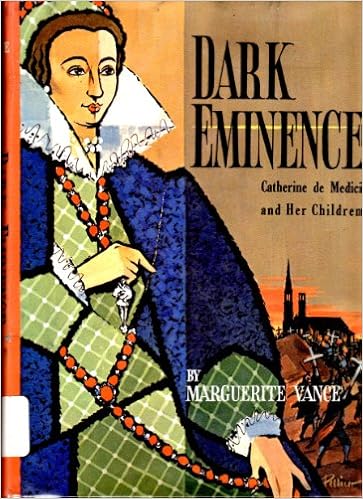I wasn’t going to publish anything until after June 1, but this doesn’t really count as it was for school, and I was going to have to do it anyway.
Dark Eminence by Marguerite Vance
Catherine de Medici and Her Children

I don’t know if I’ve mentioned it, but this school year (2015-2016), we’ve been studying the Renaissance, Reformation, and the Age of Exploration.
We’re finishing up this week with school and the 1500s. And I’ve got to review this book, Dark Eminence, and write a report about Catherine de Medici’s life for school. Why not share it with you?
It’s a little-known book that gives you an accurate, unbiased account of the life of Catherine de Medici. *shivers*
I actually had a dream about her chasing me down and making me do what she wanted me to do (which was marry her icky son) a couple nights ago. Um … yeah.
~ ~ ~ ~ ~
The Life of Catherine de Medici
Catherine de Medici was born in 1519 in Florence, Italy, in the Medici palace. Her father was Lorenzo de Medici, Duke of Urbino (1492-1519). Her mother was Madeleine de la Tour D’Auvergne. Her parents both died when she was a baby, and she spent the first six years of her life in Rome under the watchful eye of her uncle, Pope Leo X. She then returned to Florence (c. 1525) to live with her aunt and uncle.
In 1527, the Medici family became very unpopular in Florence, and Catherine, the eight-year-old child was sent to the Dominican convent of Santa Lucia. A few months later, she was transferred to the convent of Santa Caterina of Siena, then to Santissima Annunziata delle Murate. In 1528 when her aunt died, the nine-year-old little girl was alone in a city filled with her enemies.
She was taken away from the convent after that to Rome where her grandfather’s cousin, Pope Clement VII, now reined. Since Catherine was six years old, he and Francis I of France had been negotiating terms for an engagement between Catherine and the King’s second son, Prince Henry, Duke of Orleans, and at the age of fourteen she was sent to France to marry this prince she’d never laid eyes on before. On October 28th of the year 1533, she became the Duchess of Orleans.
The match was frowned upon by the French court. Catherine, though rich enough, was the daughter of a merchant with no true royal blood running through her veins. She was shunned, insulted. Of course this was embittering, and Catherine held a grudge.
Catherine’s husband’s big brother died in 1536; she was to be the next queen of France if all went well. However, this was not a happy time for Catherine. Her husband was neglectful of her at best, and she ‘d yet to produce an heir. The court wanted to replace her. Only by humbly begging Francis the I, her father-in-law, to protect her was she able to save her marriage and position.
In 1543, her son was born, who would be Francis II of France. After that, Catherine gave birth to six more children between 1545 and 1554, Elizabeth (Queen of Spain, 1545-68), Claude (Duchess of Lorraine, 1547-75), Charles IX (King of France, 1550-74), Henry III (King of Poland, later King of France, 1551-89), Marguerite (Queen of France, 1552-1615), and Hercules (Duke of Alencon, 1554-84). Of all her children, only Marguerite would outlive her.
They were, for the most part, a sickly, fretful bunch. Catherine had complete control over most of them with the exception of Marguerite, who never would obey her, and she used them as pawns. Her goal was to establish the House of Valois in France as supreme. She would have her revenge and her power through her children. Let the court try to shun her now; “that Italian girl” would rise!
King Francis I died. In 1547, Catherine’s husband was crowned King Henry II of France. Around this time, Mary Stuart came to France. She was to marry the heir-apparent Francis II; for now she was sort of the ward of the court. In 1558, this marriage came about. Catherine did not particularly like Mary, however. I don’t blame her; Mary Stuart was the stupidest woman who ever walked the face of the planet, always befriending enemies of powerful people and putting incriminating things in writing.
At the same time, Catherine was scheming for a marriage between Don Carlos, son of Philip the II, King of Spain, and Elizabeth. But Philip II decided he’d rather marry Elizabeth himself. Catherine decided that a marriage with the father was as good – if not better – as a marriage to the son. She agreed, and poor little Elizabeth was carted off to Spain in 1559.
This year, 1559, Henry II of France died in a jousting accident. The crown was passed to his weak little son, Francis the II of France. He only reined for a year; in 1560, his delicate health failed him once and for all and he died, having spent his short reign as a pawn of his wife’s French relatives, the Guises, much to Catherine’s distress. Mary Stuart was sent back to Scotland.
(In 1559, Claude, Catherine’s uglier, sickliest little daughter, was married to Charles III, Duke of Lorraine. She had a relatively happy life after she was no longer her mother’s pawn. She had nine children, dying in childbirth with her last one (who survived her by only a year) in 1575)
The next-in-line, Charles IX, was a pouting baby of ten years old at the time of his brother’s death.
At first, Catherine was able to manage him; as the years passed, she was unable to keep control of her unruly boy. They disagreed violently over and over again, arguments usually ending with the King rolling all over the floor screaming and Catherine in tears. Charles began to allow other people to influence him besides his mother, some of them Huguenot supporters, and Catherine couldn’t stand that.
She arranged for a marriage between her daughter Marguerite and the King of Navarre, Henry IV. He was a Huguenot, and Catherine hated him. And after their wedding came the dreadful carnage which historians generally say that Catherine de Medici guilty of. And she probably was.
And so, on August the 22nd and 23rd of 1572 came the St. Bartholomew’s Day Massacre. Huguenots, a Protestant group in France, were killed by the thousands: men, woman, and children. Guise and his followers stormed the streets shouting, “Kill! Kill! Kill all the Huguenots by the King’s command!” Of course, the King’s command was only given after the Queen Mother convinced him to give it.
After this event, Charles was swamped with guilt. He died two years later in 1574, leaving his young wife, Elizabeth of Austria, and a daughter. (None of Catherine’s children produced sons, interestingly enough. A God-given miracle, perhaps? 😉 )
Henry III, Catherine’s favorite son, was now king. He was not popular. When he died (well, was assassinated) shortly after his mother in 1589, France was rather relieved. His had been ridiculous and idiotic and temperamental.
After him, the King of Navarre, Marguerite’s former husband, reigned, and France became a much better place because of him, for he allowed the citizens to worship God as they pleased.
So Catherine de Medici died a disappointed woman, January 5th 1859. Her dreams of an empire ruled by her and her children and her children’s children on for generations had died despite her cruel ruthlessness, possibly because her children were weak enough to be pawns, but not long-lived enough to do anything useful as a pawn.
Do we like Catherine de Medici? Nope. But can we justify her actions? Well, that really depends on your viewpoint. Looking at her life from a Biblical perspective, we see a wicked, cruel, cold, conniving woman who deserves whatever she gets, which is most likely burning in hell if you consider her religious indifference except for furthering her own political goals.
From a Machiavellian perspective, however, she was a relatively good ruler who made some mistakes which doomed her. Now I’m thinking, “What a good idea it would be to read The Prince again and study Catherine de Medici more thoroughly and see how she stands up to the laws laid out in Machiavelli’s book.” And now I’m thinking, “Why would I want to do that? I don’t care about this witch!”
~ ~ ~ ~ ~
Review of Dark Eminence
If you’re looking for an unbiased account of the life of Catherine de Medici and her children, this is the book for you. It’s also somewhat enjoyable in its own way, and if you want to know how to be a terrible mother, well, you can find out here! It’s well-written and orderly. At times I wish it had had more about Catherine and less about her children.
4/5 stars
Content
Mentions of a mistress. Mentions of violence. It’s about Catherine de Medici. XD
~ ~ ~ ~ ~
Yes, I realize that that was long and boring. I don’t really expect you to read it. It’s just my schoolwork.
Just so you know, I’m bad at writing essays and reports and that kind of stuff. And if you ask me to do something like, “Compare Mary, Queen of Scotts and Elizabeth I of England,” I just stare blankly. I really need to work on that skill. 🙁
~Kellyn Roth


12 Responses
This was actually kinda interesting. I knew bits and pieces of this time of history already, but I think that you did an excellent job!
Thanks! I do better with these kind of things if I just have to list a bunch of facts. XD
Ooh, that was pretty interesting and informative. Not that I’m going to check the book out or anything…but it was cool to learn about. I also really like the book’s title…
Yeah, I know! I wish I could use it in some book! 😀
Ooh, that could be really interesting. I’m not sure how you’d incorporate it but it does sound cool.
I know! Like …… ok, I have no idea for a novel with that title. But I love it anyway. XD
I do love the title “Dark Eminence”. It’s awesome.
*nods* Hmm. Maybe a book about … an evil … something … that’s threatening to take over the land and … ok, that’s weird AND cliché. XD
An evil something threatening to take over the land? Practically every fantasy book ever. All you need is a chosen hero who is the only one who can stop it and you’ll be perfect.
Yeah … super cliché. XD